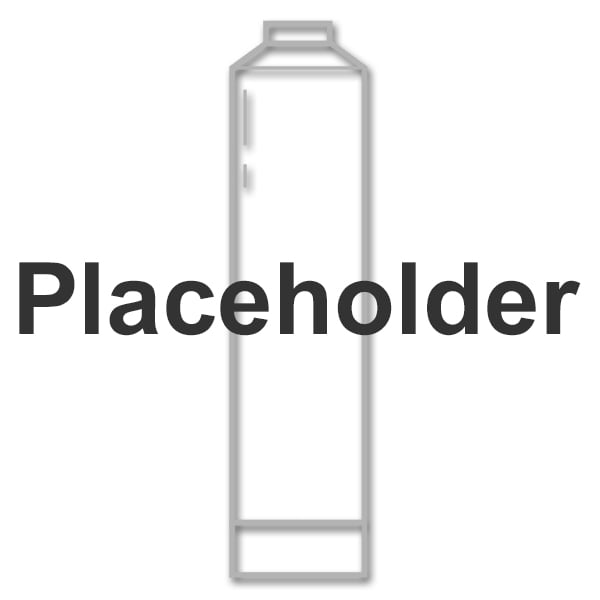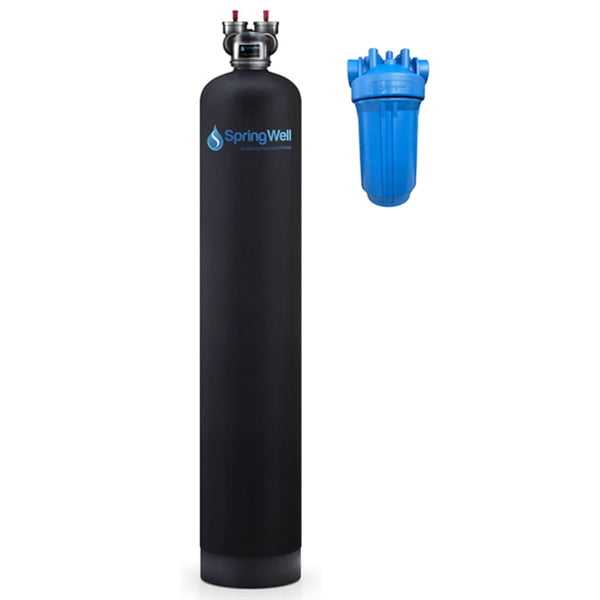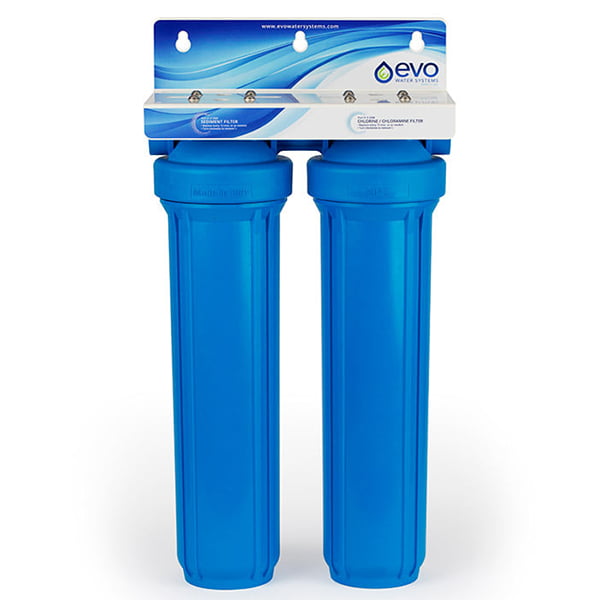Review: Dr. Mercola Pure & Clear Whole House Water Filter System
Written by: Gene Fitzgerald // Expert Fact-Checking: Buddhini Dolapihilla, MBSS // Last Updated: Aug 4, 2023
This page may contain affiliate links. If you buy a product or service through such a link we earn a commission at no extra cost to you. Learn more.
The Dr. Mercola Pure & Clear City Water System is a tank-based whole house water filter designed for municipal water treatment.
At first glance, it offers similar performance to other whole house filter systems – although its lack of catalytic carbon isn’t ideal.
Let’s take a closer look at this filter and see if it fulfills the claims made by the manufacturer.
Dr. Mercola Pure & Clear Whole House Water Filter System – All Specs
- Model: Pure & Clear City Water System
- Last Price: $1,164.97
- Annual Maintenance Cost: ~$60
- Filter Media/Process: 5-Micron Sediment, KDF-55, GAC, 0.35-Micron Sediment
- Filter Stages: 4
- Flow Rate: 7 gpm
- Filtering Capacity: 600,000 gal
- WxHxD: 10″x48″x10″
- Weight: 48 lb.
- Water Temperature: 40-90 °F
- Water Pressure: 20-100 psi
- Warranty: 6 Years
Dr. Mercola Pure & Clear City Water System – Key Features
The Dr. Mercola Pure & Clear City Water System is a tank-based whole house water filter featuring four filter stages.
- First, a 5-micron sediment pre-filter removes dirt and other large particles
- Then KDF-55 filter media and coconut shell carbon remove a wide variety of organic chemicals and heavy metals (including chlorine).
- Lastly, a 0.35-micron post-filter is used to remove undissolved minerals.
That said, the system looks a whole lot like the Aquasana Rhino whole house water filter and it may simply be the same model with different branding applied – you’ll soon find out if this is good or bad.
The Mercola filter offers a flow rate of 7 gallons per minute, which is less than impressive for a whole house system. This would only be enough for smaller houses or condos/apartments with 2 bathrooms or less.
The main tank will last for 600,000 or 6 years (whichever comes first), while the sediment pre-filter lasts for 1 to 3 months and the post-filter lasts for 6 to 12 months. Combined the annual cost of pre- and post-filter replacements comes to about $60, making it highly affordable to maintain.
The manufacturer offers a 6-year warranty on the system and a 30-day return policy.
Side note: Dr. Mercola also offers a similar model designed to filter well water, which features KDF-85 instead of KDF-55 and catalytic carbon instead of regular activated carbon. This version was designed to target iron and hydrogen sulfide – common contaminants found in well systems. The unit might be worth looking into even if you’re on city water (catalytic carbon removes a greater range of contaminants compared to regular activated carbon).
Dr. Mercola Whole House Filter Pros
The Mercola whole house water filter will provide adequate filtration of chlorine and disinfection byproducts – 97% according to the manufacturer. It should be stated that the system does not come with NSF certification, so there is no way to independently verify this claim.
While periodic pre and post-filter changes are required, the annual cost comes to just $60, making it relatively inexpensive to maintain when compared with many other competitor systems.
Additionally, the package comes with 4 pre-filter cartridges (which means you won’t need to re-order for the first year). The system also comes bundled with an installation kit, making installation easier to take care of.
What Contaminants Are Being Removed?
First, the 5-micron pre-filter will remove dirt, sand, and other debris that could clog the later filter stages or your home’s water-consuming appliances.
Next comes the tank stage. KDF-55 media + mineral stone reduce chlorine and soluble heavy metals like lead, mercury, nickel, and chromium 6. It will also help control bacteria, algae, and scale buildup while balancing pH levels.
The coconut shell carbon will remove a wide range of chemicals including chlorine, pesticides, herbicides, industrial solvents, volatile organic compounds (VOCs), and disinfection byproducts. Mainly though, it will filter out bad tastes and odors associated with chlorine.
Lastly, the 0.35-micron post-filter eliminates undissolved hardness minerals.
Installation
Installation of the Mercola system is no more complex than other tank-based whole house water filters. One thing to note is the system must be installed by a licensed plumber to not void the warranty. This is a bit of a drawback obviously, as most other whole house systems don’t have this condition.
Let’s take a look at the installation process nonetheless.
Tools and Materials needed for installation:
- Drill
- Adjustable wrench
- Channel locks
- Pipe cutter
- PVC primer and glue
- Plumber’s tape
- Copper wire and grounding clamps (if copper pipes are present)
- Garden hose
- Bucket and rags
Before installation, it’s important to make sure you have enough space to mount the system in an upright position. It must not be installed on its side to ensure proper contact with the filter media. The unit should also be kept upright at all times during installation.
Installation steps:
- Locate the inlet and outlet ports on the tank housing. Remove and discard the protective red caps on both ports.
- Before installation, the system must be flushed out using surge flushing. This will purge all of the fine carbon dust present in the tank bottom. To complete this process, follow these steps:
- Attach a garden hose to the tank inlet using the included adapter.
- Turn the water on slowly until water starts flowing out of the tank’s outlet port. Complete this process somewhere with good drainage or use a bucket to collect the water outflow. The water will appear discolored and black from the carbon particles – this is normal and indicates the process is working.
- Flush for 15 minutes and then begin the surge flushing This involves turning the water supply on for 30 seconds followed by turning it off for 30 seconds continuously for 15 minutes or until the water coming out of the outlet port is clear with no visible particles or discoloration.
- After flushing, ensure the white-colored washers are installed in the inlet and outlet ports. Remove the garden hose and place the unit in your installation location.
- Now, turn off the main water supply. Connect the unit to the main water line using the included components. Be careful not to overtighten the fittings, as this can cause leakage or broken fittings. Don’t use pipe dope, as this will void the warranty. Use an NSF-certified primer, glue, and plumber’s tape. Leave two or three threads exposed and do not surpass 7 layers of plumber’s tape.
- Ensure the inlet and outlet piping assembly are properly braced and supported. Also, be sure to have any additional parts needed for installation on hand – including tubing, fittings, clamps, and mounting screws.
- After installation is done, slowly turn on the main water line and check the entire system for leaks.
- Lastly, open the closest water faucet to the system and allow the water to flow for between 5 and 10 minutes to flush out any remaining carbon particles.
The Package (Parts)
- Pure & Clear City Water System
- 4x 5-Micron Pre-Filter Cartridge
- 35-Micron Post-Filter Cartridge
- Filter Housings
- 2x Filter Support Brackets
- 4x 3” PVC Nipples
- 2x PVC Unions
- Shut Off Valve
- Garden Hose Adapter
- Filter Housing Wrench
Maintenance
The only regular maintenance required is changing the pre and the post-filter on schedule. The manufacturer recommends changing the pre-filter every 1 to 3 months, and the post-filter every 6 to 12 months.
To change the pre-filter:
- Shut off the water flow at the shut-off valve. Then relieve pressure in the water line by running water for 2 to 3 minutes at the nearest faucet.
- Position a bucket below the pre-filter to collect any water that comes out. Turn the pressure port on the pre-filter housing counterclockwise. Then, remove the blue chamber by turning the lower ring clockwise using the supplied filter wrench. Remove and discard the old filter.
- Clean the inside of the blue chamber with warm water and soap, rinse, and dry.
- Insert a new filter inside the filter housing.
- Clean the O-ring and lubricate it using food-grade silicone grease. Ensure the O-ring is seated properly in the groove and attach the housing back to the filter mount.
- Turn the system back on by deactivating the shut-off valve.
- Operate the system with a bucket in position to catch any leakage.
Changing the post-filter follows the same procedure as above.
Manual
Here is a link to the official manual:
https://media.mercolamarket.com/assets/pdf/manual/manual-city-water-filter.pdf
NSF and Other Certifications
The system comes with no NSF or other certification as far as we are aware.
Earlier Product Versions
There was an earlier product version with a lower filtration capacity of 300,000 gallons.
Dr. Mercola Whole House Water Filter Cons
The biggest drawback to the Mercola whole house filter is its relatively low flow rate of 7 gallons per minute. Realistically, this would only be enough to accommodate homes with 2 bathrooms or less, so it wouldn’t work for larger-sized homes.
The system must also be installed by a licensed plumber in order not to void the warranty, which is a drawback if you’re interested in a DIY install.
The lack of any NSF testing or certification is another issue, which is something some would expect to see on a system in this price range.
Lastly, there does not appear to be many user ratings for the system. Again, for a system costing this much, user ratings would help evaluate the system’s quality and performance.
Dr. Mercola Pure & Clear Review: Our Verdict + Best for
Overall, the Dr. Mercola Pure & Clear City Water System should work well for basic municipal water filtration, but it offers too little to justify its high price tag in our opinion. For one, the system uses regular carbon and not catalytic carbon. What’s more, flow rates are on the lower end and you are not allowed to DIY-install.
Our Rating in Detail:
- Filtration Performance: 3.5/5.0
- Filter Capacity (Life): 4.0/5.0
- Purchase Price: 3.0/5.0
- Annual Cost: 5.0/5.0
- Overall: 3.5/5.0
Comparison to Other Whole House Water Filters
Let’s take a look at how the Dr. Mercola whole house water filter stacks up against some of the most popular POE filter systems on the market – the SpringWell CF and the Kind E-1000.
The SpringWell CF whole house filter is a tank-based system that’s similar to the Mercola in many ways but offers significantly better performance in several key areas. The SpringWell uses catalytic carbon rather than regular activated carbon, which means it will eliminate chloramine along with a variety of organic chemicals. Additionally, the SpringWell offers better flow rates (9 to 20 gpm, depending on the size selected), and a significantly greater capacity (1,000,000 gallons).
Kind’s E-1000 is a 2-stage cartridge-based whole house filter with a 5-sediment pre-filter and a catalytic carbon filter stage. It costs way less upfront than the Mercola, but requires annual filter changes totaling about $145 annually – so overall costs will add up over time.
Comparing the two systems above with the Mercola system shows several key gaps in the Mercola. Firstly, both the above systems can be installed on your own without voiding the warranty. Additionally, both the Kind and the SpringWell are well-regarded systems with hundreds of user reviews backing up their claims. Also, they both have significantly better flow rates – making them suited to larger homes. Lastly, both have limited lifetime warranties and significantly better satisfaction guarantees (4 months for the Kind, and 6 months for the SpringWell).
This completes our review of the Dr. Mercola Pure & Clear City Water System. If you have any questions please don’t hesitate to leave a comment below!
Information provided on BOS is for educational purposes only. The products and services we review may not be right for your individual circumstances.
We adhere to strict editorial guidelines. Rest assured, the opinions expressed have not been provided, reviewed, or otherwise endorsed by our partners – they are unbiased, independent, and the author’s alone. Our licensed experts fact-check all content for accuracy. It is accurate as of the date posted and to the best of our knowledge.




